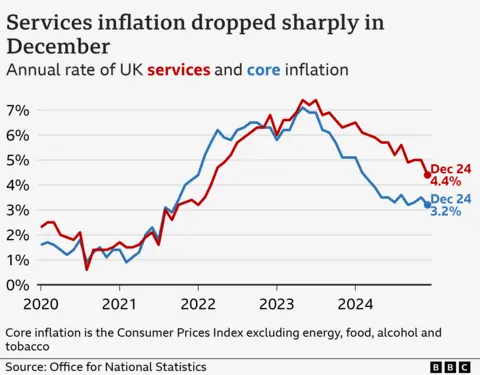 Getty Images
Getty ImagesA marginal decline in the overall inflation rate would normally not determine much, if anything.
Inflation up to 2.5% rather than 2.6%, this does not change much in the great economy, nor in the compression of the cost of living felt by households. This drop is entirely explained by lower hotel prices and a smaller than usual increase in airfares in December.
But this unusually large drop of 0.1% signals relief, and some respite for Chancellor Rachel Reeves, because of what lies behind it.
Core inflation figures, which show where price pressures are going over the year, are what are most watched by the Bank of England in terms of interest rate cuts.
Core inflation, which excludes the direct impact of volatile energy and food prices, is now at its lowest level in four years, having fallen to 3.2% in December from 3 .5%. Services inflation is at its lowest level in two years, at 4.4%, after a sharp decline from 5%. This is the real positive news.

For real nerds, inflation in supply chains, including in services, also indicates moderate inflationary pressures.
The UK inflation picture can therefore be presented in a rather different light. While no one can predict exactly how the Bank of England will react, it dispels objections to an interest rate cut next month. Markets this morning scrambled to keep pace, now pricing in further rate cuts after February this year.
However, two big uncertainties remain: whether President-elect Trump will impose tariffs on the scale he has threatened, and how UK businesses will react to the upcoming National Insurance Contributions (NIC) increase in April and the increase in the social minimum. salary. An increase in energy prices which will weigh on bills is also expected for April.
Tariffs and upcoming changes to NICs and the minimum wage may not be as problematic for the UK economy as some warn.
While some expect companies to raise prices following the budget changes, some companies may also choose to cut salaries with lower-than-expected annual increases. The overall inflationary impact depends on how businesses respond and, in truth, we don’t know yet.
Likewise, the tariffs imposed by Trump risk being inflationary for the United States and therefore affecting American interest rates. But some at the Bank of England envisage a scenario in which cheaper tariff imports, for example from China, would be diverted to the UK, helping to curb UK inflation.
What actually happens is again uncertain, but the outcome may be counterintuitive to what people expect.
So the marginal fall in UK inflation can be seen as something of a firebreak, for now, ending the frothy hysteria seen in recent weeks. Those who short the UK on international markets will see that there is another side to this bet. UK inflation is in the middle of the G7.
That said, what is known as a global “bond market rage” remains in place, sensitive to each new data. The British government still needs to convince on the details of the growth plans. This will mean an acceleration of infrastructure, industrial and commercial strategies.
Market borrowing rates remain at levels where the chancellor will likely have to correct her spending plans with further cuts before Easter, in order to meet her self-imposed borrowing rules.
The shadow cast on the inflationary outlook and therefore on all markets by Donald Trump’s unconventional trade policy weighs heavily.
The turbulence has not disappeared. Inflation is expected to rise again in the coming months. But at present, the UK’s headline and core inflation figures are all moving in the right direction. It is a safe and welcome port for now, but the seas remain rough.



